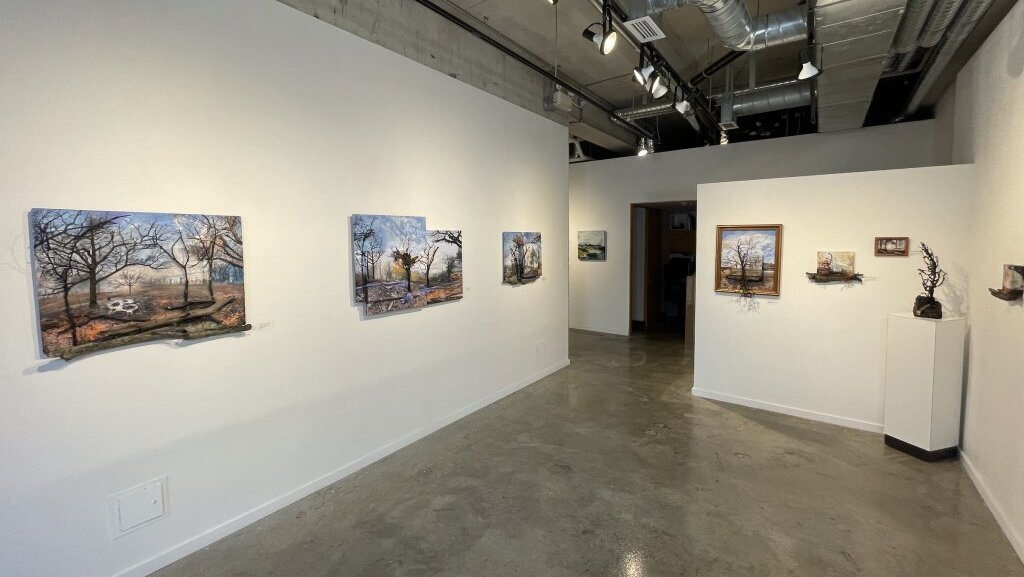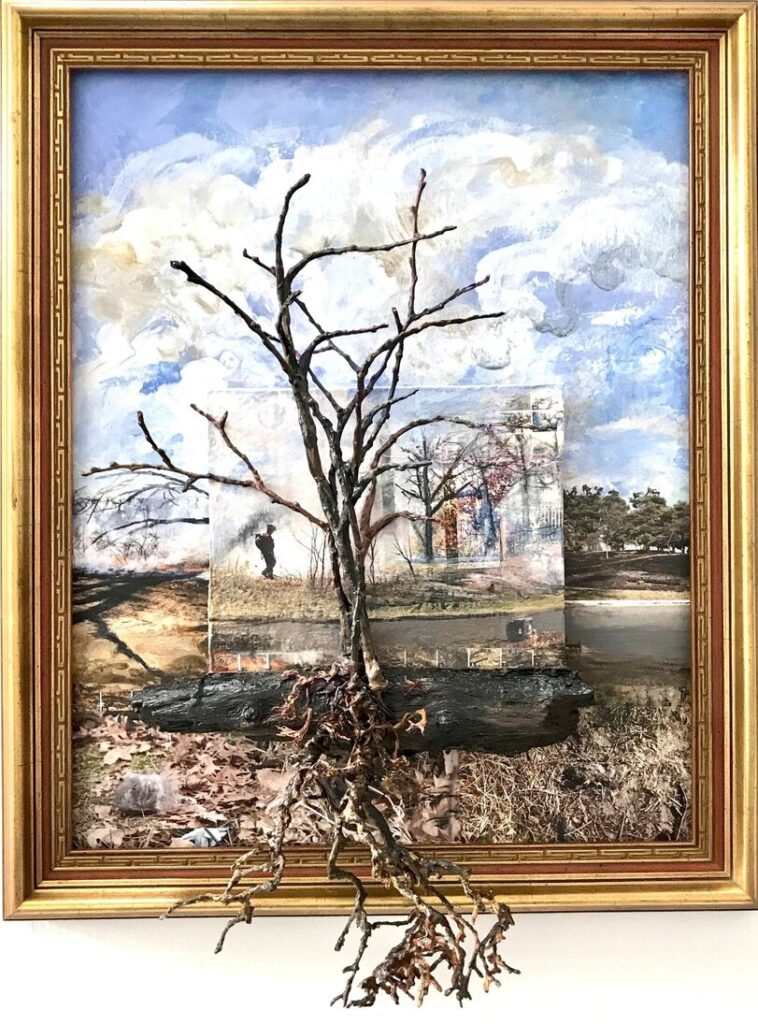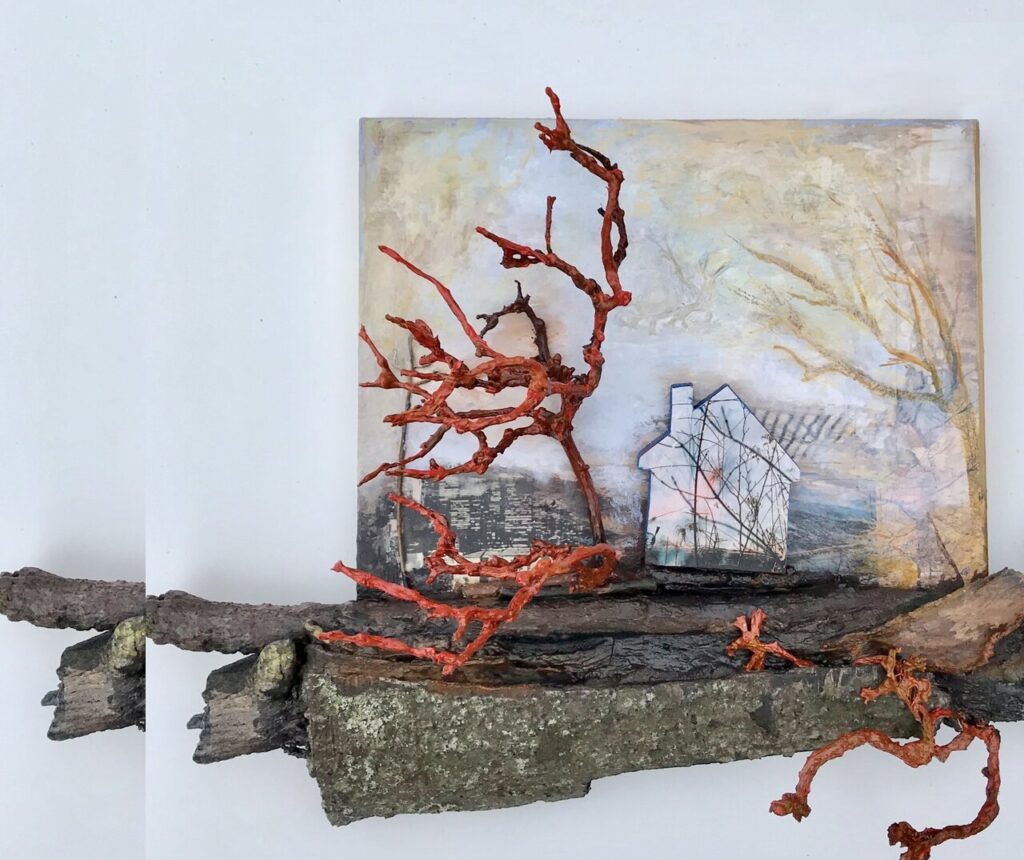The sole subject of Frances Patella’s Fired Up at the Propeller Art Gallery is the Oak Savannas, whose homes reside in High Park. Typically, the savannas depend on natural wildfires, for instance lightning strikes, to maintain their ecosystem. The City of Toronto organizes prescribed burns in various areas around the park to revitalize this endangered plant community, utilizing the scorching heat from the fire to stimulate the germination of the oaks’ acorns. Patella documents this process in her photo-based mixed media artworks, layering wood panels and photographs akin to mosaics or tiles, and incorporating twigs, logs, and leaves from the prescribed burn sites themselves, creating an immersive three-dimensional landscape.
Installation view of Frances Patella, Fired Up at the Propeller Art Gallery
Patella’s work is first and foremost photography; she uses unconventional methods of photography in order to capture the ever-elusive nature of time. To create the images that are used as the foundation for her pieces, she revisits burn sites “over days, weeks, or years later” and “under different conditions or perspectives”, she writes in her artist’s statement. She often uses the technique of double exposure, where you expose the film twice over the same frame, combining the two shots into one. She would save the film she used at one shoot to use again later; in this way, it is completely up to chance how the photograph will turn out. Patella manages to capture both the powerful energy of fire and the changes of time itself by surrendering to their transformational processes.
Frances Patella, West Ravine, High Park, mixed media on wood panel, 28 x 42 in.
This is evidenced by the presence of the red-tailed hawks in the left side and top-right corner of “West Ravine, High Park.” Over the time Patella photographed this site, these hawks slowly began returning to these newly revitalized habitats. Moreover, scattered throughout the exhibition are a few tiny sculptures of homes. A photograph of a burn site overlays the simple shape of a triangle-roofed house with a chimney, sitting on top of burnt wood. A reminder that many other wildlife forms call these Oak Savannas home and will soon follow the red-tailed hawks to reclaim it.
Frances Patella, House, Lambton Park 2 (Front), mixed media, 5 x 3 in.
Each piece in the exhibition is an amalgamation of Patella’s time-warp photographs. The photos are decidedly laid out and layered onto wood panels like a puzzle. Several of the works use a number of these wood panels, which are also layered in varying arrangements that some areas either recede or reach out towards the viewer. By bringing together a collection of photos that each capture an individual moment into an array of facets and planes, Patella creatively makes a tangible representation of space and time. Viewers are able to experience the natural transformations of the Oak Savannas through time in one place.
Frances Patella, Hawk Hill Burn, mixed media on wood panel, 10 x 14 in.
Patella cites Robert Rauschenberg as an inspiration for her unique photo-based mixed media practice. Rauschenberg is most known for what are called Combines; he would use found objects in his artwork, transforming everyday objects into something new by its change of context. Similarly, Patella would collect a myriad of things from the burn sites to integrate into her artwork. For example, a large piece of log is placed along the bottom frame of “Hawk Hill Burn” as if the photograph, along with some twigs, are growing right out of it. A log being used as a bottom frame is a motif that Patella repeats in many of her pieces. Sometimes, the log is positioned at the bottom of a wood panel already within a larger canvas, where a twig and its root are emerging from it, like in “West Rd., High Park with Forester”; an awe-inspiring metaphor for the cyclical quality of nature, that from the burnt wood, new life can arise.
Frances Patella, West Rd., High Park with Forester, mixed media on wood panel, 29 x 22 in.
In addition to photography, collaging, carpentry and the creative integration of nature, Patella paints directly onto the photos or the collected twigs and leaves. She delicately paints atmosphere into her scenes, like hazy smoke dissolving into a clear blue sky, or a majestic tree cloaked by the dancing fumes of a recently extinguished fire. In one piece, a twig is painted completely in a vibrant red, producing a stark contrast from the smoke-filled photographic backdrop, recalling the power that nature possesses. Patella blurs the lines between painting and three-dimensional sculpture that pulls viewers into her carefully-crafted reality where art is nature, and nature is art.
Frances Patella, House with Red Tree, mixed media on wood panel, 11 x 15 in.
Fire is more than just an element in nature. Fire is alive. It is energy. Fire breathes and transforms. Feed it too much, you might lose control. But not feeding it enough, it will disappear all on its own. Patella demonstrates a keen understanding of fire; that it is not always destructive, but can wield the ability to restore and breed new life.
Rebekah Barona
*Exhibition information: Frances Patella, Fired Up, November 13 – December 1, 2024, Propeller Art Gallery, 30 Abell St, Toronto. Gallery hours: Wed – Sat, 1 – 5:30pm, Sun 12 – 4pm.







Thank you Rebekah for this wonderfully written article about my exhibition. You have captured the essence of what I am trying to accomplish with this new body of work. You have also indicated nuances that I was not aware of.
Frances